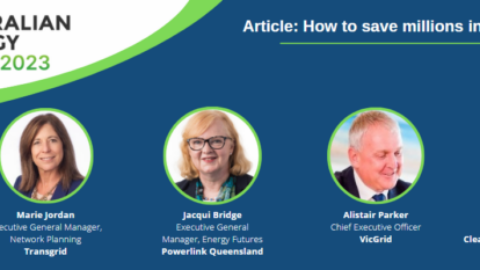A new Energy Security Board (ESB) paper suggests that a two-sided energy market would allow greater visibility of demand to ensure power system reliability and security in the future.
The discussion paper explores what a two-sided market – where all types of energy users actively buy and sell electricity – could look like. It will be followed by a detailed analysis at the end of 2020.
It also looks at the best ways to value essential services such as voltage and primary frequency control, system strength and inertia response to ensure they are available when needed most over the coming years.
According to the paper, a two-sided market will give networks access to consumer energy demand information that is currently hidden ‘behind the meter’, and would add exponentially to the value household energy technology contributes to consumers and the broader system.
However, the paper found that creating such a market would require a major overhaul of how electricity buyers and sellers are described and regulated – and new systems to govern how bidding takes place in the market.
The ESB will recommend by the end of 2020 a design to bring greater aheadness into the market which works with other market design elements currently being developed, such as integrating distributed energy resources such as home solar panels and batteries, and reforming the way generators access the grid.
Energy Security Board Chair, Dr Kerry Schott, said consumers are already participating in the electricity market through their use of things like solar panels, electric vehicles and smart devices – but this information is largely hidden, making it very hard for the Australian Energy Market Operator (AEMO) and other market participants to know whether supply will meet demand.
“A two-sided market will change all that because consumers and those who participate in the wholesale market on their behalf will be active in responding to price,” Dr Schott said.
“When prices are high, they can conserve their own use and supply electricity to the market and when prices are low, they can increase their use.
“Because this behaviour will be transparent and in real-time the information itself becomes a tool to keep the power system operating securely and reliably and can fill gaps when the sun isn’t shining and the wind isn’t blowing.”
The paper argues this major shift will also mean rethinking some key fundamentals – such as shedding traditional views of how certain participants act in the market and how the rules should apply to them.
It suggests replacing the diverse arrangements that exist today around retailers, generators and aggregators with two simple categories – those who use electricity and those who sell it on behalf of end users.
This would mean the market rules can be streamlined and make it easier for new types of traders to enter the market. It could also mean that single end users could be their own trader for some services – and use other traders to buy or provide other services for them.
Technology would also mean that consumers won’t need to monitor electricity prices and decide how or when to participate, as these decisions could be set up to happen autonomously or in an agreed way via their retailer or aggregator.
A key pillar in designing this new type of market will be how to ‘schedule’ consumers to participate in the market. Being scheduled into the market means participants are required to make bids and offers to produce or consume electricity and are bound by certain obligations.
Australian Energy Market Commission Chair, John Pierce, said having more traders providing information to the market about their intentions would remove imbalances between supply and demand and make the system cheaper to run.
“But the current scheduling system is designed for large generators and users and has significant technical requirements so will need to adapt. We need to strike the right balance between obligations on participants and the incentives to trade in the market,” Mr Pierce said.
“We can trial how this might work through reforms currently being progressed such as the AEMC’s upcoming rule changes on demand response that will allow large energy customers to routinely trade their energy use in the market.”
AEMO’s Virtual Power Plant (VPP) trials are another avenue to trial how to schedule demand-side participants into the market.
AEMO CEO and Managing Director, Audrey Zibelman, said a two-sided market would fundamentally change the way energy is traded to benefit consumers.
“As the energy system transitions, we have the opportunity to harness technology and establish a new market framework which empowers and rewards all energy system users, from small customers to large generators – to ensure the supply and demand mix is being orchestrated in the most efficient manner, while providing the services needed to keep the system safe, secure and reliable,” Ms Zibelman said.
“This will involve establishing a framework which values the full breadth of essential system services and scheduling them in a coordinated way ahead of the time to ensure they are there when the system needs them.”
Australian Energy Regulator Chair, Clare Savage, said, “The transition towards two-sided markets has the potential to bring significant benefits to consumers by rewarding them for selling energy back into the grid when it is needed the most.
“A key success factor for these markets will be ensuring that the consumer experience is a positive one and consumers can leverage the benefits of new technology and services through products that are simple to understand and engage with.”
The discussion paper identifies a sliding scale of options, from voluntary participation of energy users to full participation. All have benefits and drawbacks, so while full participation is the gold standard, a transitional approach might help the market adapt.
The paper says other major projects already underway are fundamental to realising the vision of a two-sided market. These include the Australian Energy Market Commission’s reforms on the way generators can access the energy grid and the Open Energy Networks project.
Energy Security Board work plan
Two-sided markets are part of the ESB’s plan to improve the reliability, security and affordability of the national electricity market. Also today, the ESB has released a discussion paper on system services and ahead markets – another key arm of this work.
The plan was discussed at the 20 March COAG Energy Council meeting. It will be coordinated through the post 2025 market design project and will involve three key phases:
- Interim measures to improve the security and reliability of the grid before summer
- Improving access to the grid for new generators, two-sided markets, ahead markets
- Examining investment signals needed to ensure a smooth transition to more renewable energy
















